
Contact

Home
Loch Ness Monster part 7

1934

continued
Monster of Loch Ness
IS IT A SEA-SERPENT?
The Argus (Melbourne, Vic.)
Date: January 13, 1934
Page Number: 9
(From Our Correspondent)
LONDON, Dec. 14. — Loch Ness is a narrow land-locked basin, extending for about 22 miles inland from Inverness to Fort Augustus—not the place in which a naturalist would normally look for a sea- serpent. Consequently there was general doubt regarding a water monster which was alleged to have appeared in the Loch in August, and which was reported more than once in the early autumn. But the story has persisted, and, at the time of writing, more than 50 Scotsmen and Scotswomen declare that they have seen the creature, sometimes with the naked eye and sometimes with a telescope or binoculars. The witnesses range from an inspector of the Automobile Association to Mr. B. A. Russell, who is a schoolmaster at Fort Augustus. Mr. Russell says that he saw the monster in the full sunshine of on October morning, watched it for 10 minutes, and drew a picture of it. Apparently a black serpent-like head and neck protruded from the surface of the water for five or six feet, the whole having the appearance of a prehistoric creature about 60 feet long. Other observers tell of a series of "humps"—two, three, four, or five of them—which recall the familiar pictures associated with mariners' tales of the sea-serpent. The creature is alleged to propel itself by a couple of fins at the side, and some observers tell of frill-like gills where the neck joins the head. All sorts of suggestions have been made to account for the appearances. Some people say that a grey seal has been washed in from the sea, but Mr. Russell will not hear of the suggestion. What he saw was a creature of serpentine form, he says. Of that he is assured.
Here the story of the Loch Ness monster remained until publicity led to the revelation of a number of cognate facts. It seems that "sea-serpents" have been seen in the Loch before, in particular in a pool of the Moriston River, near Invermoriston, 20 or more years ago. Indeed, Highland legend carries back the story of the Loch Ness sea monster to early Christian times. The life of Saint Columba, first Abbot of Iona, written by St. Adamnan in the 7th century, tells that the blessed Columba was staying in the land of the Picts, and found it necessary to cross the River Ness. Accordingly, he told one of his companions to strip and swim out to a coble on the opposing bank. Half way over the swimmer was attacked by a monster which rushed upon him with a great roar and open mouth. But St. Columba raised his hands on high, formed the saving sign of the Cross in the empty air, invoked the Name of God, and commanded the fierce monster, "Think not to go further nor touch thou the man. Quick! Go back." Then the terrified beast fled back- wards, as if dragged by cords. Highland mothers living on the banks of Loch Ness have been wont for centuries to frighten their naughty bairns with the threat that "the water kelpie in the Loch would hae them if they werena' guld."
Zoological experts are frankly dubious about the monster of Loch Ness, as they have always been dubious about reports of the sea-serpent. The Natural History department of the British Museum deals not in speculative theories, but in specimens. "Send us the Loch Ness monster in the flesh, and we will tell you all we know about it," it says. A recent "sea-serpent" washed up at Santa Cruz in California was identified by the British Museum experts as a badly decomposed bottle-nosed whale of the genus Hyperoodon. They expect the Loch Ness monster to be explained in similar fashion. Nevertheless, even if mass hallucination accounts for some of the sea-serpent stories, and zoological ignorance for others, it is curious that so many people should suddenly see a strange monster in Loch Ness. Cinema photographers—some in motor-cars and others in aeroplanes—have invaded the district hoping for a really historic news film. Other enthusiasts have proposed schemes for capturing the alleged serpent with nets, and sportsmen are out with guns or harpoons to kill it. As the Loch is 750ft. deep in some places, sudden death would be of small service to science. The body, supposing it exists, would merely sink in deep water, and be lost for ever.
Romantic possibilities of the Loch Ness monster are still unexploited. In 1875 the crew of the Pauline witnessed a wonderful fight between a sea-serpent and a sperm whale off Cape San Roque. The gigantic serpent, so the story went, suddenly rose from the depths, wound itself in two mighty coils about the whale, and proceeded to crush its foe in the manner of a boa-constrictor. The crew of the Pauline said afterwards that they heard the whale's ribs cracking one after another, with reports like those of a small cannon.

Commander Gould seemingly was most impressed by that of Mr BA Russell MA, the Fort Augustus schoolmaster, who had seen Nessie on 1
October 1933. The dominie, the Commander wrote, had recorded his sighting “in almost ideal conditions.”
He was on an eminence,
overlooking the southwestern extremity of the Loch, and about 100 feet above the water level. The day was brilliantly sunny, and the
surface of the Loch as smooth as glass, there was no haze, and the creature was in view for 12 minutes (10.10am to 10.22am) moving
slowly from left to right at a maximum distance of 800 yards and a minimum of 700. What he saw, and subsequently sketched, was a serpentine
head and neck, arched like a swan’s, dark in colour, rising fully five feet out of the water and turning occasionally from side to
side. He saw nothing of the body, but a V-shaped ripple spread off from the neck at the point where it met the water. The creature
ultimately sank slowly and disappeared.
SOURCE
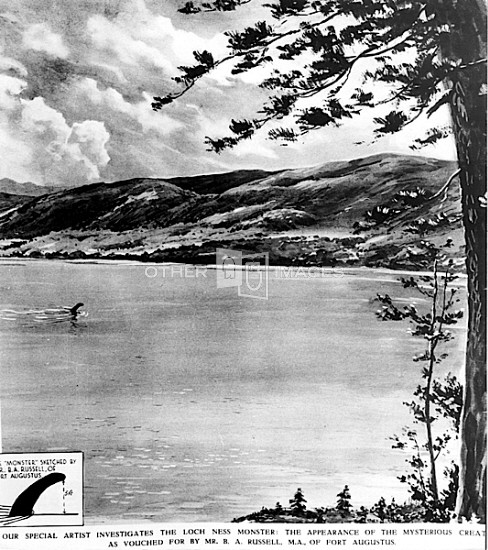
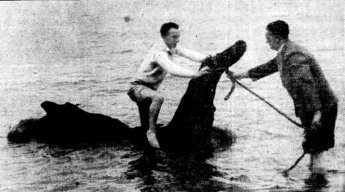
Note the similarity of Russell's sketch (above) to that of a log (left) that washed up on the shore of Loch Ness later in the same month.

Santa Cruz Sea Monster
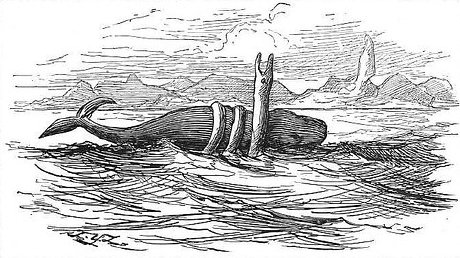
We the undersigned, captain, officers, and crew of the barque
Pauline, of London, do solemnly and sincerely declare that on July 8th,
1875, in latitude 5° 13', longitude 35° W., we observed three large sperm whales, and one of them was gripped round the body with
two turns of what appeared to be a large serpent. The head and tail appeared to have a length beyond the coils of about thirty feet,
and its girth eight or nine feet. The serpent whirled its victim round and round for about fifteen minutes, and then suddenly dragged
the whale to the bottom, head first.
GEORGE DREVAR, Master,
HORATIO THOMPSON,
HENDERSON LANDELLO,
OWEN BAKER,
WILLIAM LEWAN
LOCH NESS "MONSTER"
A Survey of an investigation
Sunday Times (Perth, WA)
Date: January 14, 1934
Page Number: 12 S
It was cabled from London a few weeks back that Lieut.-Commander R. T. Gould, R.N. (retired) had interested himself in the reports of the Loch Ness "monster," and had personally interviewed 51 persons who had reported seeing the mysterious denizen of the deep.
In a recent issue of the London "Times" appears a detailed report by Lieut.-Commander Gould. His conclusions are set out as follow:—
A preliminary analysis of my data suggests the following conclusions. The "monster" has a length of at least 50ft. or so, with a maximum diameter of some 5ft. The neck and tail are long and tapering. The head is comparatively small, not much larger than the neck—which can be elevated to a considerable height above the water. The color of the body, under strong sunlight, is indeterminate, something between dark brown and dark grey. The skin is rough, presenting a granulated (but not scaled) appearance. A small ridge, darker in color, runs along the crest of the back. The body appears to be flexible, to some extent both laterally and vertically. There are small appendages, possibly gills, at the sides of the head where it joins the neck. Finally there are at least two, and possibly four, propelling fins or paddles.
On the whole, despite the advocates of a "surviving plesiosaurus," this and other "sea-serpent" cases suggest to me nothing so much as a vastly enlarged, long-necked, marine form of the common newt. However, that is a matter for a qualified zoologist with an open mind.
There can, at all events, be little question that Loch Ness contains at least one specimen of the rarest and least-known of all living creatures. Unless it comes and goes—as it may do—it has been there some years: I have first-hand evidence of its having been seen in 1932 and 1931, as well as second-hand accounts of several earlier appearances. Presumably, it made its way up the Ness, by night, during a spate, and has found the loch an admirable refuge from its natural enemies, the sperm whale and the "killer."
Is it to have other enemies? Not being a grey seal, a salmon, or any species of wild bird, the law gives it no protection—it is ferae naturae at the mercy of any "sportsman's" rifle or harpoon. Attempts to kill it have already been made, happily, without success—and, equally, without justification. "Sea-serpents" are inquisitive, but timid—possibly fish-eaters, but certainly harmless to man. If shot, the Loch Ness creature will probably sink and, unless trawled for with promptitude and great good luck, be lost to science for ever. There seems to be a clear case for a short Act (as recently suggested by Mr. A. Russell Smith) forbidding anyone to molest it: a measure framed on the lines of that passed many years ago, by the New Zealand House of Representatives, to protect "Pelorus Jack."
Loch Ness is so large—22½ miles long by a mile and upwards in breadth, with a maximum depth of some 750ft.— that the chance of capturing the creature alive and uninjured is remote. There remains the possibility of studying it by means of photography. An ordinary photograph, unless taken when the head and neck are elevated, would probably reveal little—only a photograph taken from vertically over the creature, or nearly so, could exhibit all its characteristic and unusual features. An aeroplane—even of the auto-gyro type—is scarcely suited to this work, by reason of its noise and speed; but excellent pictures could probably be secured, next summer, from a small "blimp" carrying a pilot and a photographer, and directed by wireless telephony in accordance with telephone reports from observation posts round the Loch.


More on R. T. Gould:
Loch Ness Newt?
PUBLIC SCHOOL CAMP
Gymkhana at Cowes
The Argus (Melbourne, Vic.)
Date: January 15, 1934
Page Number: 3
Another "Loch Ness Monster" appeared at Cowes on Saturday, but this time it was fashioned out of an old ladder, kerosene tins, and a painted head. The "monster" was one of the features of the gymkhana held on the beach at Cowes by the boys of the public school camp.
...

DEEP-SEA MONSTERS
Skipper's Yarn of Australian Seas
The Horsham Times (Vic.)
Date: January 16, 1934
Page Number: 5
The Loch Ness "monster" is giving ample cause for keen speculation. The subject is intriguing enough to arrest attention, and it would probably be wise if an effort were made to solve the mystery (writes Edward Willace in the "Weekly Scotsman.") It is the confirmed belief of many, and none more than the old-time sailor who roamed the sea in sailing ships, that, hidden away in the vast depths of the ocean, are monsters of incredible size, which at any moment might play havoc with the unwary. Recently, while enjoying a quiet, confidenltial crack with an old retired skipper, one not usually over-communicatiive regarding the sensation, he told me about some the strange sights he had seen in lonely parts of distant seas. After listening to some hair-raising tales, I ventured to ask if he had ever thought about publishiing his experience. "What good would that do?" he replied, with a grin, "nobody would believe me: the world is full of sceptics." Because of his own experience, however, he believes in the Loch Ness monster. During the conversation he related the following nerve-racking adventure and I have his permission to pass it, on as proof of his belief that Loch Ness may hold a secret of world-wide interest.
"One day," he began, "when off the Australian coast, my ship, under a slight breeze, was makinig fair progress. All hands were lolling about seeking shelter from the fierce sun. The sea was like the proverbial millpond not a ripple. All at once, however, slightly to starboard there was a commotion like a miniature quake, and the sea for a considerable distance became greatly distured, as though something was boiling underneath. Suddenly, out of the turmoil there appeared, not one, but two of the strangest heads I ever set eyes on. They rose at least 10 to 15 feet out of the water, and came so near that many of us got an excellent view of them—more than we relished, because more repulsive looking brutes it would be diflicult to imagine. They were evidently in mortal conflict, jumping by the way they were lashing out at each other. So engrossed were they in their fight that they paid not the slightest heed of our approach. The more we saw of them the less we liked their company. In appearance they were nothing like the pictures drawn by imaginative artists of sea monsters. They had neither forked tongues nor wide string eyes belching forth flames of fire and brimstone. They had huge heads, however, not unlike the shape of a camel's, but very munch larger. Large protruding lower jaws full of vicious-looking teeth of pearl whiteness. Instead of large eyes, they seemed to be blind, at least we could trace nothing resembling either eyes or ears. The skin, from the neck downwards, hung in ragged folds adding to the otherwise hideous nightmare appearance, while the noise they made was not unlike the squeal of an angry pig and could be heard at a great distance. We could only guess at their size, but, for at least 100 feet on either side the sea was in a turmoil. From this we gathered that the brutes were of enormous length and thickness, as the part we did see was frosm six to nine feet in diameter. They must have sensed our nearness, even if they could not see, because as if by mutual consent, the paused in their fight and made in our direction, causing every man-jack to bolt for safety. However, after swimming quite close to the ship for about five miles, they disappeared, turning back in the direction from which they came. That was the last we saw of them. We parted, without any regrets on our side. Relating our experience a few nights later to another skipper, whom I met in Sydney, he told me that when crossing the same waters a few days earlier, he, too, had been followed by some huge animal, probably one or other of the same brutes. Incidentally, I wrote a full record, together with a sketch of the animals, in my log-book, but, unfortunately, on our way home, and during a severe storm, my ship became a complete wreck, and everything was lost, including my log book."

The Advertiser (Adelaide, SA)
Date: January 20, 1934
Page Number: 9
THE timid monster of Loch Ness has achieved the distinction of becoming a general topic of conversation. Rumors of the existence of a rare marine beast of great size and prehistoric aspect have been accumulating for months past.
Now there is such a formidabis collection of reports from widely divergent sources that the public at least is prepared to believe that there is some thing uncanny living in the deep waters of the Inverness-shire loch. More over, the strange creature has swum into the columns of "The Times"—surely an unusual place in which to find a sea serpent. In a sub-leader, "The Times" acknowledges that Commander Guild, a distinguished officer who has been particularly employed by the Admiralty on work requiring minute exactitude, has come to the astonishing conclusion that 51 independent witnesses have seen in Loch Ness a living creature belonging to no species known to science. The commander has examined witnesses with a lawyer's scrupulousness, it hastens to add, and collated the results in the form of an article, which "The Times" saw fit to publish over four columns of its main pages.

Add to this testimony the daily reports that come from Loch Ness, giving further evidence of the "monsters" existence, the fact that the Chief Constable of Inverness-shire has taken measures to protect, not the people from the monster, but the monster from the people, and the invitation to the Secretary for Scotland to conduct
Shy Disposition
UNFORTUNATELY, before observers have had time to study it intently, this shy denizen, of no known era, plunges its head beneath the waves, and returns to the murky depths of the loch. Whence it came no one can more than guess. If it came into the loch from the sea it may have swum over one of the weirs in the River Ness during a heavy spate—hence the anxiety of some interested naturalists to have grids put across the weirs to prevent its escape—or it may have been spawned in the depths of the loch, which is 750 feet deep, countless ages ago, and, through some biological freak, have hibernated through the centuries, finally to be yielded up to man's gaze. Meanwhile, aeroplanes are flying over the loch vainly searching for it, inn-keepers are reaping a welcome winter harvest from the curious, and everyone is enjoying the realisation that after all there may be a sea serpent!
Loch Ness, where the strange sea creature has been reported. In the foreground are the ruins of Castle Urquart.
an official investigation, even using R.A.F. planes, and it will be seen what an effect has been wrought upon the simple Scottish mind. But it is the simplicity of the Scottish mind and its customary refusal to be hurried into transports of excitement that lend such strong support to the stories of the strange sea beast. All the stories are told sparingly and almost deprecatingly, and all tally to an astonishing degree; the animal seems to be a hump-backed creature, 30 to 40 feet long, dark grey to dark green in color, with a serpent-like head carried by a slender neck, which sometimes appears to be held about five feet out of the water, and which weaves from side to side as its owner speeds through the water.
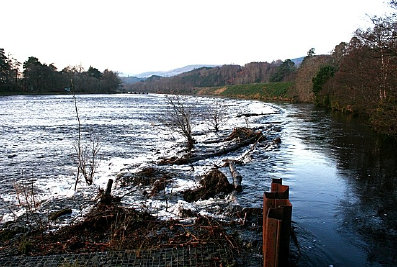
Weir on the River Ness.

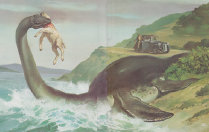
Contents
Also see here for another similar comparison (Fraser's sketch).


















